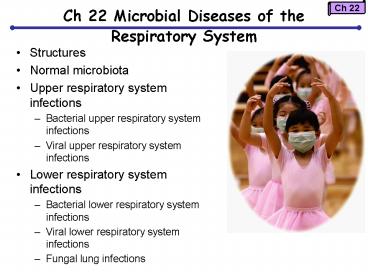Ch 22 Microbial Diseases of the Respiratory System - PowerPoint PPT Presentation
1 / 25
Title:
Ch 22 Microbial Diseases of the Respiratory System
Description:
Microbial Diseases of the Respiratory System. Bacterial Diseases (upper) ... Respiratory syncytial virus (RSV) Hantavirus pulmonary syndrome (HPS) ... – PowerPoint PPT presentation
Number of Views:647
Avg rating:3.0/5.0
Title: Ch 22 Microbial Diseases of the Respiratory System
1
Ch 22 Microbial Diseases of the Respiratory System
- Structures
- Normal microbiota
- Upper respiratory system infections
- Bacterial upper respiratory system infections
- Viral upper respiratory system infections
- Lower respiratory system infections
- Bacterial lower respiratory system infections
- Viral lower respiratory system infections
- Fungal lung infections
2
Microbial Diseases of the Respiratory System
- Bacterial Diseases (upper)
- Streptococcal respiratory diseases
- Diphtheria
- Sinusitis and otitis media
- Viral Diseases (upper)
- Common cold
- Bacterial Diseases (lower)
- Bacterial pneumonias
- Pneumoncoccal
- Primary atypical (mycoplasmal)
- Klebsiella
- Legionellosis
- Tuberculosis
- Pertussis
- Inhalational anthrax
- Viral Diseases (lower)
- Influenza
- Severe acute respiratory syndrome (SARS)
- Respiratory syncytial virus (RSV)
- Hantavirus pulmonary syndrome (HPS)
- Other viral respiratory diseases
- Fungal Infections (lower)
- Coccidiomycosis
- Blastomycosis
- Histoplasmosis
- Pneumocystis Pneumonia (PCP)
3
Structures of the respiratory system
4
Structures commonly involved in upper respiratory
infections
- infection
conjunctivitis - infection of
tear ducts dacryocystitis - infection otitis
media -
infections sinusitis or mastoiditis -
infections pharyngitis - infection
epiglottitis
5
Structures commonly involved in lower respiratory
infections
- inflammation
laryngitis - inflammation
bronchitis - infection
bronchiolitis - inflammation of
lungs/ fluid build-up pneumonitis
6
Mucociliary Escalator
- Membranes of respiratory system coated with mucus
- Mucous membranes composed of ciliated cells
- Cilia propel mucous film away from lungs
- Mucous is swallowed ?
7
Normal Flora
- Mastoid air cells, middle ear, sinuses, trachea,
bronchi, bronchioles and alveoli normally
_______ - S. aureus carried by 20 of population in ______
- streptococci,
Moraxella, diptheroids, Staphylococcus - Common pathogenic bacteria in cooler seasons
Streptococcus pneumoniae, Haemophilus influenzae,
Neisseria meningitidis
8
- Bacterial infections of the respiratory system
9
Streptococcal Respiratory Diseases
- Symptoms
- Red throat, often pus and tiny hemorrhages
enlargement of lymph nodes in neck - May include abscess formation on tonsils
- Late complications
- Causative agent
- Streptococcus pyogenes
- Pathogenesis
- Virulence associated with inhibition of
phagocytosis and production of other virulent
factors - Attaches to mucous membranes
10
Streptococcus pyogenes
11
Cell envelope of Streptococcus pyogenes
12
Streptococcus pyogenes virulence factors
13
Streptococcal Respiratory Diseases
- Epidemiology
- Most cases occur in winter/ spring
- Ingestion of contaminated food
- Prevention and treatment
- Daily penicillin to prevent recurrence in
patients with rheumatic heat disease - 10 day penicillin or erythromycin to treat
14
The Common Cold
- Symptoms
- Scratchy throat, nasal discharge, malaise,
headache, cough - Causative agent(s)
- Rhinoviruses ssRNA
- Coronaviruses ssRNA
- Adenoviruses dsDNA
- Paramyxoviruses ssRNA
- Pathogenesis
- Epidemiology
- Prevention and treatment
- Handwashing avoid people with colds
- Control of symptoms
- No vaccine because of lack of common antigens
15
Rhinovirus
16
Chest X-ray of Pneumococcal Pneumonia
17
Pneumococcal Pneumonia
- Symptoms
- Cough, fever, chill, shortness of breath, chest
pain - Causative agent
-
capsule bacteria - stimulates
endocytosis of bacteria - lyses host cells,
suppresses phagosome-lysosome fusion - Pathogenesis
- Inhalation, colonization of alveoli ?
- Fluid buildup in alveoli
- Epidemiology
- Carriers risk with alcoholism, narcotic use,
chronic lung disease, viral infections - Prevention and treatment
-
conjugate vaccine for infants - Treatment with penicillin, erythromycin and others
18
Streptococcus pneumoniae
19
Primary atypical (Mycoplasmal) pneumonia
- Symptoms
- Gradual onset of cough, fever, malaise, headache,
sore throat, excessive sweating - Unproductive cough
- Causative agent
- Pleomorphic, no cell wall
- Capsule, adhesins
- Pathogenesis
- Cells attach to ,
inhibit - Epidemiology
- Inhalation of infected droplets, mild infections
spread disease - Prevention and treatment
- Treatment with tetracycline or erythromycin
- No vaccine
20
Pleomorphic Mycoplasma
21
Klebsiella Pneumonia
- Symptoms
- Chills, fever, cough, chest pain and bloody,
thick, bloody sputum, recurrent chills - Causative agent
- Gram(-) bacillus
- Capsule
- Pathogenesis
- Aspiration of colonized mucus in throat
- Destruction of
spread via - Epidemiology
- at
higher risk - Prevention and treatment
- Treatment with cephalosporin and aminoglycoside
- No vaccine
22
Klebsiella pneumoniae
23
Types of Pnuemonia
24
Tuberculosis
- Symptoms
- Chronic fever, weight loss, cough, bloody sputum
- Causative agent
- Slow-growing
- protects
against lysis following phagocytosis -
antimicrobial drugs, detergents, desiccation - growth
of cells in cords - Pathogenesis
- Inhalation of airborne microorganisms
- 1º tuberculosis, 2º tuberculosis, disseminated
tuberculosis - Survive ingestion by alveolar macrophages
-
pathogen carried by macrophages to
bone marrow, spleen, kidneys, CNS
25
Primary tuberculosis formation of tubercules































